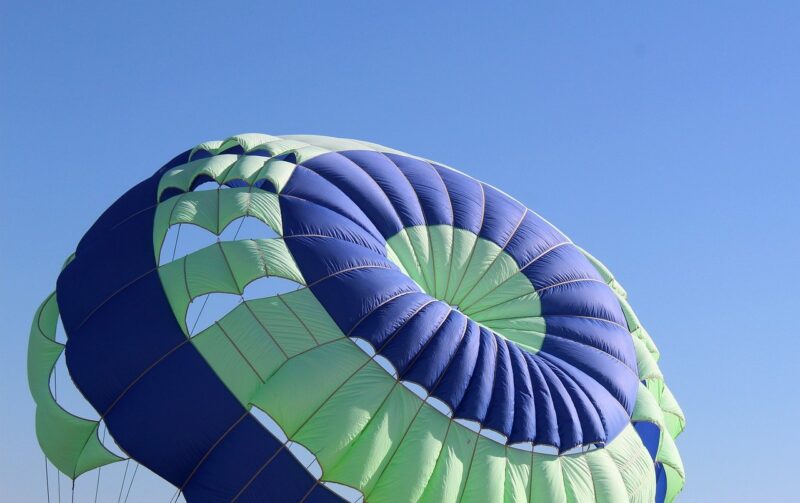
Parachutes are fascinating devices that have intrigued both scientists and adventurers for centuries. These life-saving tools function on the principle of air resistance, allowing individuals or objects to descend safely from great heights. From skydivers jumping out of planes to cargo dropping from military aircraft, parachutes play an essential role in ensuring safe descents. In this article, we will explore the science behind parachutes, how they work, their history, and the various types used today.
1. The Science of Air Resistance
Before we get into the mechanics of parachutes, it’s crucial to understand the concept of air resistance. When an object moves through the air, it collides with air molecules, creating a force opposite to its motion. This force is known as drag or air resistance. The amount of drag experienced by an object depends on several factors:
- Speed: Faster objects experience more drag.
- Cross-sectional Area: A larger surface area facing the airflow results in more resistance.
- Shape: Streamlined shapes have less drag compared to blunt or irregular shapes.
- Air Density: Denser air (like at lower altitudes) creates more drag than thinner air (like at high altitudes).
Understanding air resistance is fundamental to grasping how parachutes operate. When a parachute is deployed, it increases the surface area facing the airflow, thus maximizing air resistance and slowing down the descent.
2. How Parachutes Operate
At its core, a parachute consists of a canopy, suspension lines, and a harness. When an individual or object drops from a height, gravity pulls them downward. As they free-fall, the parachute’s deployment phase begins:
– **Deployment**: When the parachutist pulls the parachute’s release cord, the canopy unpacks and expands, forming a dome shape. This expansion increases the surface area dramatically.
– **Drag Creation**: As the parachute opens, the increased cross-sectional area creates significant drag. This drag acts against gravity, slowing the descent gradually.
– **Stabilization**: The shape of the parachute also helps in stabilization; as the canopy fills with air, it becomes a stable structure that allows for controlled descent.
– **Controlled Landing**: The design of the parachute allows for a gliding capability, enabling the user to steer and control their landing direction.
The effectiveness of a parachute depends on the type and size of the parachute as well as the weight of the person or object it is carrying.
3. History of Parachutes
Parachutes have a rich history dating back centuries, with early designs originating in ancient China and later advancements in Europe. Here are some significant milestones:
– **Ancient China**: The first known concept of a parachute dates back to the ancient Chinese, who used large cloth canopies to slow their descent from tall structures.
– **Leonardo da Vinci**: In the 15th century, Leonardo da Vinci designed a pyramid-shaped parachute, although it was never built or tested in his lifetime.
– **First Successful Jump**: In 1783, Louis-Sebastien Lenormand made the first successful jump from a height using a parachute to slow his fall.
– **Military Applications**: Parachutes gained prominence during World War I and World War II, with advancements in materials and design leading to their wide use in military operations.
– **Modern Skydiving**: Today, parachutes are not only used for military and safety applications but also for recreational skydiving, which has seen an explosion in popularity in recent decades.
Understanding this rich history gives us a deeper appreciation for the device that allows millions to experience the thrill of free-fall!
4. Types of Parachutes
Parachutes come in various designs, each suited for specific activities and needs. Here are some common types:
– **Round Parachutes**: The classic design, typically used for skydiving, military drops, and cargo. They have a simple circular shape that creates drag.
– **Ram-Air Parachutes**: These are rectangular and look more like wings. They provide better control and gliding ability, often used in modern skydiving.
– **Static Line Parachutes**: Designed for military applications, these parachutes open automatically upon exit from the aircraft due to a tethered line connected to the aircraft.
– **Cargo Parachutes**: These are specially designed for transporting goods safely from the air. They have larger canopies and can include features for stabilizing the descent of heavy loads.
– **Reserve Parachutes**: A secondary parachute carried in case the primary parachute fails.
Each parachute design benefits from advancements in materials technology, enhancing strength, weight, and efficiency.
5. Conclusion
Parachutes are incredible devices that exemplify the intersection of physics, engineering, and human ingenuity. By harnessing the power of air resistance, they allow for safe descents from great heights, whether in recreational skydiving or critical military operations. Understanding how they work and the science behind them enhances our appreciation for these life-saving tools. As technology advances, parachutes will continue to evolve, providing even greater safety and performance for users worldwide.
So, the next time you see someone leaping from an aircraft, remember the science of parachutes and the crucial role they play in making such thrilling experiences safe and enjoyable.








